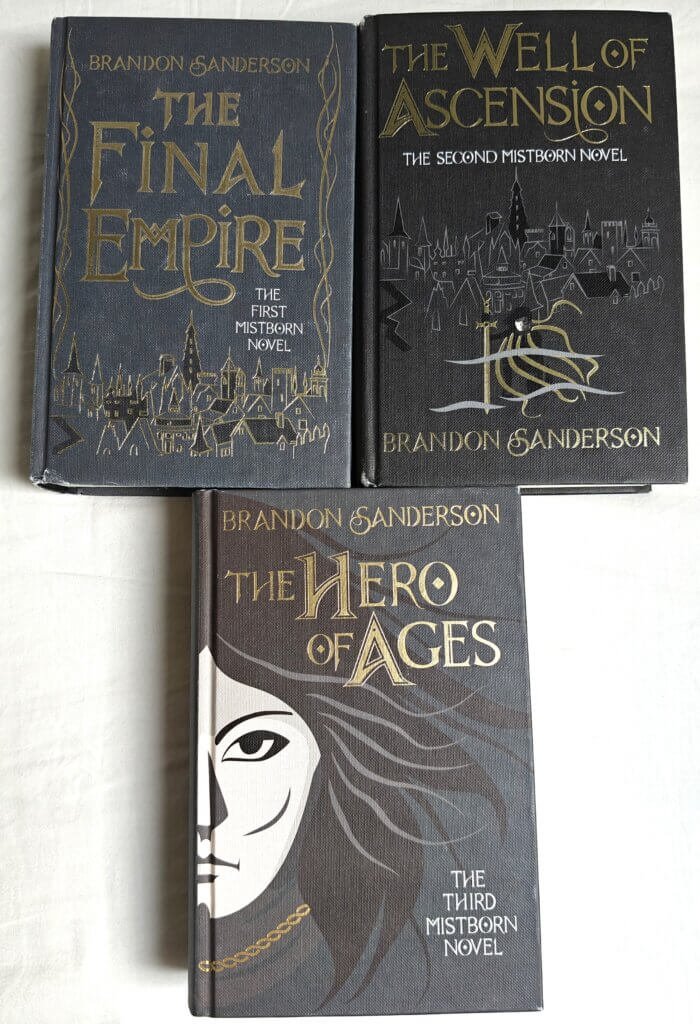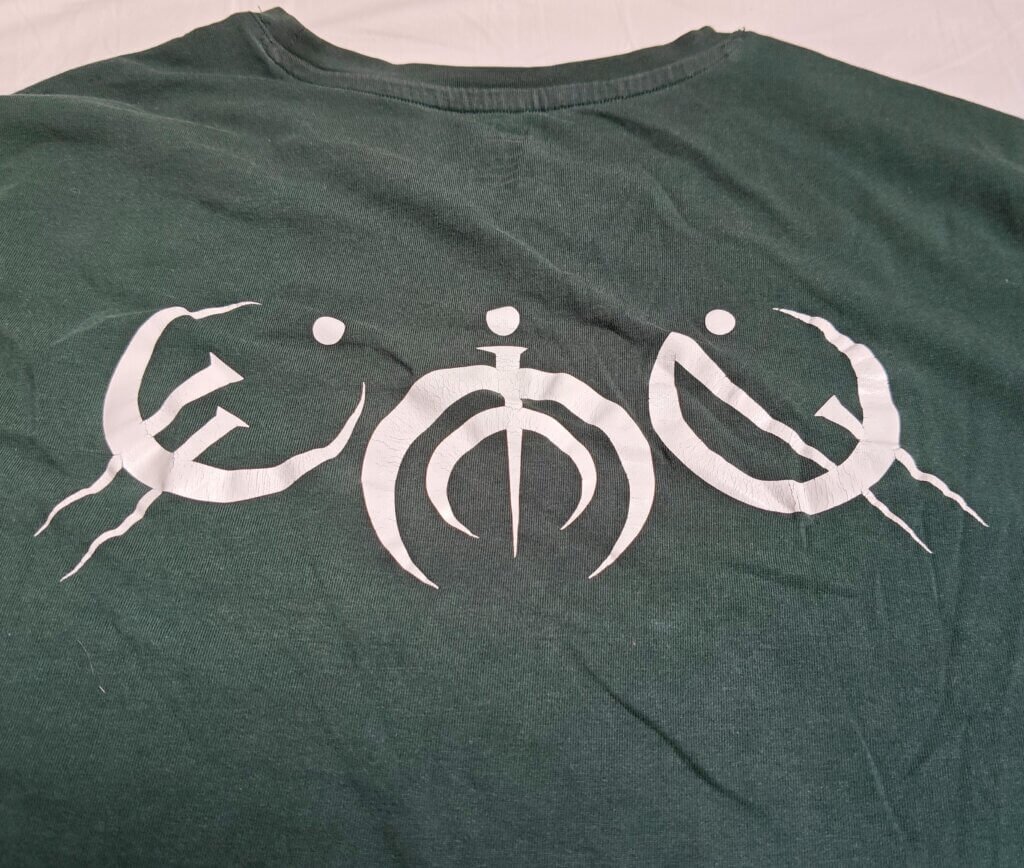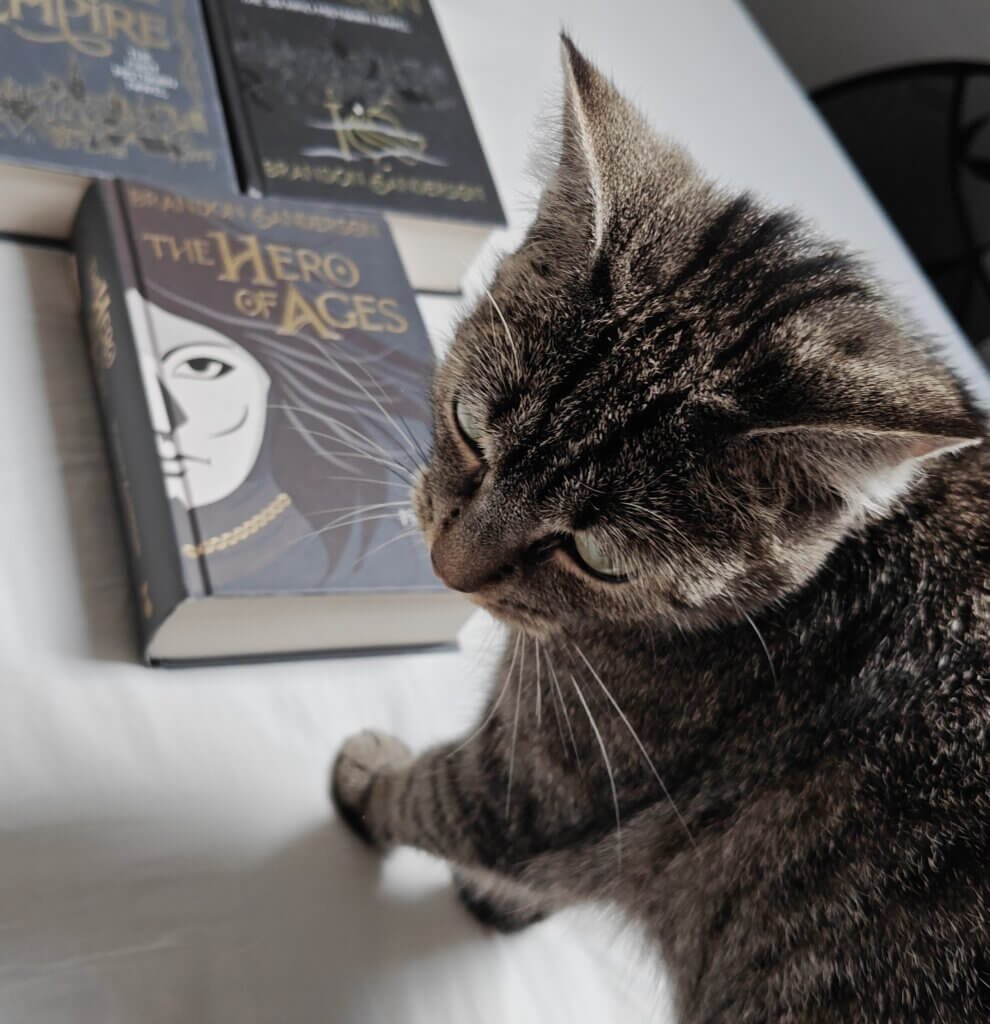When I was trying to decide between Mistborn and Stormlight Archive, I spent way too much time reading Mistborn vs Stormlight comparison guides that all seemed to miss the point. They’d compare character development and worldbuilding scope, argue about which has better magic systems, or dive into long debates about quality. None of them properly addressed what I actually wanted to know: which one should I read first if I’m trying to get into Brandon Sanderson’s Cosmere?
I was coming off a major fantasy high after discovering The Witcher books through the games, and making my way through Wheel of Time after. By then, I’d obviously heard of Brandon Sanderson. But standing in the bookstore looking at these two massive series, I felt completely lost. Do I start with the shorter, completed trilogy? Or jump into the sprawling epic everyone calls his masterpiece?
Most fantasy throws around vague magic where stuff just happens because the plot needs it to. But there’s something different about Sanderson’s approach: Mistborn’s Allomancy has actual rules you can learn and predict. Consume this metal, get this specific power. Push on metal objects, physics takes over. Characters improve through systematic practice, not convenient plot developments.
I figured this out the same way I learned to optimize builds in Elder Scrolls or master tactical systems in strategy games. The pattern recognition that helps you understand game mechanics makes learning Allomancy alongside Vin incredibly satisfying. You’re not just reading about making, but also systematically understanding how it actually works.
If you’re someone who appreciates systems that just work, whether through gaming, strategy, or just preferring logical consistency, approaching this Mistborn vs Stormlight choice strategically will completely change your reading experience of Sanderson’s Cosmere stories. Both series are incredible, but understanding why the systematic approach matters sets you up for years of amazing Cosmere reading.
Why Mistborn Works Like Your Favorite RPG
I almost missed this connection entirely. When I first picked up The Final Empire, I was just looking for more fantasy after Wheel of Time. But something clicked around page 100 that I wasn’t expecting.
Mistborn Magic System: Actual Resource Management
Allomancers burn metals to fuel their abilities, exactly like managing mana or stamina in any RPG you’ve played. You can’t spam your most powerful moves; you need strategic resource planning. Burn pewter faster for maximum strength but drain reserves quickly, or sustain it longer for extended enhancement. Every fight becomes this efficiency puzzle where you’re weighing immediate power against sustainability. Reading Vin’s first real combat scene, I realized she’s basically managing resource bars in real time. That familiar strategic thinking, just in book form!
Allomancy Explained: Physics You Can Predict
The Mistborn magic system follows actual physics consistently; no handwavy “because magic” explanations. When characters use Steelpushing and Ironpulling, you can predict the outcomes based on simple rules you already understand. Push something heavier than you, you get launched backward. Pull something lighter, it flies toward you.
I started scanning scenes the same way I’d check environments in games: spotting anything that could be used tactically. Same pattern recognition, different medium. It just clicked that everything followed rules I could actually learn – really tickled that logical part of my brain!
RPG-Style Character Progression
Characters develop signature techniques by mastering underlying principles, not through convenient power-ups. Vin’s journey from terrified street thief to confident Mistborn follows logical learning curves. When you understand how the magic works, her achievements feel earned rather than lucky.
This systematic approach is incredibly satisfying. Oftentimes in fantasy stories, magic just happens when the story needs it to. Mistborn gives you rules you can actually learn and apply to the mysteries presented in the story. If you enjoy figuring out how systems work (optimizing character builds, understanding game mechanics, or just tickling that logical part of your brain), this will absolutely click!
The fact that there are multiple Mistborn tabletop RPGs isn’t coincidental. The magic system translates perfectly to game mechanics because Brandon Sanderson thinks like a systems designer. When reading Mistborn, you reading about cool magic effects as well as systematically learning how an entire framework operates!
Most fantasy readers don’t realize how satisfying this can be until they experience it. Once you do, vague “magic happens because reasons” can start feeling pretty unsatisfying by comparison.
Should You Read Mistborn Before Stormlight?
Short answer: yes, definitely. Long answer: it depends on what kind of reader you are, but probably still yes!
Mistborn vs Stormlight: Tutorial vs Open-World
Think of Mistborn as a focused tutorial campaign for the wider Cosmere universe. Three books, one magic system, clear progression from basic concepts to advanced applications. You learn Allomancy alongside Vin, building understanding step by step without getting overwhelmed.
Stormlight Archive is like jumping straight into a massive open-world RPG. Five thousand-page books, multiple overlapping magic systems, complex politics spanning a huge continent, tons of assumed Cosmere knowledge. You can start here (plenty of people do!) but you’ll spend half your time confused about references and connections you should understand.
I’ve made this mistake before, with other series. Jumped into complex stuff thinking I could handle it, then spent weeks feeling lost about things that would have been obvious with proper foundation. Not fun!
Why Reading Order Actually Matters
This choice genuinely confuses new readers, which makes sense. Both series get recommended constantly, but most guides just act like it’s a matter of preference. Technically, it’s true that either works, depending on the reader, but this is completely unhelpful when you’re trying to make an actual decision.
If you appreciate systematic progression, Mistborn teaches core Cosmere concepts within manageable scope. Investiture, Shards, Realmatic Theory: they’re all introduced gradually while you’re focused on learning one magic system. When you eventually tackle Stormlight, those concepts enhance your understanding instead of adding to the confusion.
The Strategic Advantage of Starting with Mistborn
Understanding the systematic magic in Mistborn makes Stormlight’s multiple magic systems feel like exciting expansions rather than overwhelming complexity. The pattern recognition skills you develop through three focused books transfer immediately to more complex applications.
And let’s be practical: Mistborn’s first trilogy is finished. Complete story, satisfying conclusion, no waiting for the next book. If you start with Stormlight, you’re committing to following an ongoing series that won’t conclude for another decade or so. Yes, the first arc is finished, but trust me when I say that The Hero of Ages ended way more conclusively than Wind and Truth!
The systematic approach pays off. Start with The Final Empire, master the mechanics, then expand to the bigger Cosmere universe. I assure you, building that foundation properly makes everything that comes after so much more satisfying.
Complete Mistborn Reading Order Guide
Most Mistborn reading order guides just dump a numbered list and call it helpful. That’s like handing someone a game manual without explaining why the progression matters. Let me break this down for you properly.
Mistborn Books in Order: Start with Era 1
There’s seven main Mistborn books total, plus some novellas, but don’t let that intimidate you. Start with the original trilogy, also called Era 1. Think of it as the tutorial campaign that teaches you everything you need to know!
The Final Empire works perfectly as a sort of “character creation” and magic system introduction. This is the definitive first Mistborn book! You learn Allomancy basics alongside Vin while the world and stakes gradually expand. No overwhelming complexity, just systematic introduction to how everything works.
The Well of Ascension adds political complexity and more advanced magic applications. Now that you understand the fundamentals, Sanderson can explore deeper implications without losing you.
The Hero of Ages brings everything together with massive reveals and even some Cosmere connections. By this point, you’re fluent enough in the system to appreciate both the epic scope and the systematic payoffs. You might even be able to predict some of the climaxes, if you’ve been paying close attention!

Each book builds on the previous foundation. Skip around and you risk breaking the learning progression.
Era 2: Advanced Content After Mastery
Once you’ve mastered Era 1, you might be excited to find out there’s four more books! Mistborn Era 2 happens 300 years later in the same world, showing evolved Allomancy in a Wild West setting. Magic plus guns plus industrial technology creates fascinating new applications of familiar rules. Since you already understand how Allomancy works, you can focus on creative applications rather than learning the basics.
It’s like playing a sequel that uses the same core mechanics but in completely different contexts. Familiar foundation, exciting new possibilities.
Mistborn: Secret History Timing (Don’t Read This First)
The biggest Mistborn reading mistake I see is people starting with Mistborn: Secret History because it’s shorter or they found it first. Don’t do this! Secret History provides a behind-the-scenes perspective on Era 1 events, but reading it early ruins major surprises and assumes emotional investment you haven’t built yet.
When people ask “what’s the first Mistborn book,” the answer is always The Final Empire. Not Secret History, not any of the novellas. Trust Sanderson’s intended progression. Secret History reads perfectly after Era 1 but before Era 2, giving you insider knowledge that enhances rather than spoils the experience.
Understanding Allomancy: Magic That Actually Works
Now that you know the strategic reading approach, let me explain why this systematic thinking actually matters for enjoying Mistborn. Before I encountered Allomancy, I thought most fantasy magic was basically the same. Wizards have wands, stuff happens, whatever. Sometimes it got more complex than that, but ultimately magic was just magic. Then I started reading The Final Empire and realized what I’d been missing.
How Allomancy Works: Metal-Based Powers
This is where it gets really interesting from a systematic perspective. Most people in the world of Mistborn who can use Allomancy are Mistings: they can only burn one specific metal. Think of them like specialized character classes in an RPG. You’ve got your Thugs (pewter-burners) who are basically tanks with enhanced strength. Your Tineyes (tin-burners) are scouts with superhuman senses. Coinshots (steel-burners) and Lurchers (iron-burners) are your mobility specialists.
Then you have Mistborns like Vin: the multiclass characters who can use all metals. That’s incredibly rare, like finding someone who can spec into every skill tree simultaneously.
| Metal | Effect |
| Iron | Pulls on nearby metals |
| Steel | Pushes on nearby metals |
| Tin | Enhances senses |
| Pewter | Enhances physical abilities |
| Brass | Soothes emotions |
| Zinc | Riots emotions |
| Copper | Hides Allomancy |
| Bronze | Reveals Allomancy |
What clicked for me was realizing this was about tactical specialization versus tactical flexibility, not just about having different abilities. A Coinshot who has mastered Steelpushing for twenty years will probably outclass a new Mistborn in pure Steelpushing technique. But the Mistborn can combine pewter-enhanced strength with Steelpushing for applications the specialist never even considered.

Steelpushing and Ironpulling: Physics-Based Magic
The physics part is what really got me. Steelpushing and Ironpulling obey Newton’s laws consistently. Push something heavier than you, you fly backward. Pull something lighter, it flies toward you. Every metal object becomes a potential tool once you understand the mechanics.
What blew my mind was how tactical this gets in practice. Coins aren’t just coins anymore. You can Push them as projectiles, or drop them behind you to Push off for a boost forward. Nails in walls become anchor points. Pull on a nail that’s heavier than you, and you get yanked toward the wall instead of pulling it free.
Reading Vin work through these applications felt exactly like watching someone master advanced game mechanics. She’s not just “using magic,” but actually identifying metal sources, calculating force vectors, and chaining multiple Pushes and Pulls together for complex maneuvers. Push off scattered coins to launch upward, then Pull on an iron fitting ahead to change direction mid-air.
I started looking at scenes differently after understanding this. Same environmental awareness I’d developed through years of gaming, just applied to a completely different ruleset. Every piece of metal became tactically interesting once you knew how the force mechanics actually worked.
In Short: Quick Answers
Should you read Mistborn before Stormlight Archive?
Yes, definitely. Mistborn Era 1 is three focused books teaching core Cosmere concepts systematically. Stormlight Archive is five massive volumes with multiple magic systems and assumed knowledge. Starting with Mistborn builds the foundation that makes Stormlight significantly more rewarding.
Can I start with Stormlight Archive instead?
You can, but expect a thousand pages before things click. Many readers get overwhelmed by the scope and bounce. If you appreciate systematic progression – like learning game mechanics before endgame raids – Mistborn first makes more sense. Save yourself the frustration.
How does Mistborn’s magic system work?
Allomancers burn metals to fuel specific powers. Push on metal objects (Steelpushing), Pull them (Ironpulling), enhance strength (pewter), sharpen senses (tin). Everything follows consistent physics – push something heavier than you, you fly backward. It’s resource management like mana bars in RPGs.
Which series is better overall?
Wrong question. Mistborn teaches you how to read Sanderson’s systematic magic and Cosmere connections. Stormlight applies those concepts at epic scale. Asking which is better is like asking whether tutorial levels or endgame content is superior – you need both for the complete experience.
How long is each series?
Mistborn Era 1: three books, roughly 2,000 pages total. Stormlight Archive: five books (so far), approximately 4,500 pages and counting. Neither series is finished long-term, but Mistborn’s first trilogy has complete conclusion. Stormlight won’t conclude for another decade minimum.
Begin with The Final Empire: Your Mistborn Starting Point
If you’ve made it this far, you already know what you need to do. Start with The Final Empire, experience that systematic alongside Vin, and see if it clicks the same way it did for me!
The gaming background helps, but honestly, anyone who appreciates when things just make sense will probably love this approach. When you’re reading Vin’s first real Allomancy training scenes, you’ll know pretty quickly whether this is your kind of fantasy.
After finishing the original trilogy, you’ll have that solid foundation for tackling the Stormlight Archive, or even Mistborn Era 2, or honestly any other Cosmere series. The pattern recognition skills transfer immediately. Plus, you’ll actually understand all those Cosmere references everyone talks about online, instead of just nodding along.
I spent way too much time in that bookstore trying to decide between these series. Turns out the answer was simple: start with the one that teaches you how to read the others. The Final Empire is that book!
Trust me on this: once you’ve experienced magic with actual rules, handwavy fantasy can start feeling pretty weak by comparison.
